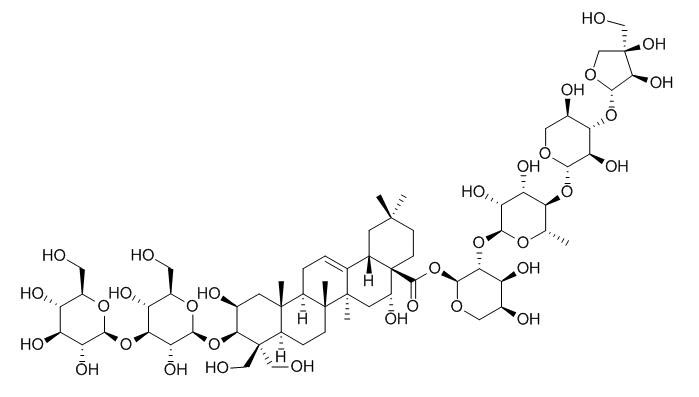Platycodin D2
Platycodin D2 , a less hemolytic saponin, can improve specific cellular and humoral responses to hepatitis B surface antigen in mice, it could be safely used as adjuvant eliciting Th1 and Th2 immune responses. Polygalacin D2 has anti-cancer activity, it exhibits significant inhibition on the proliferation of five kinds of cultured human tumor cell lines.
Inquire / Order:
manager@chemfaces.com
Technical Inquiries:
service@chemfaces.com
Tel:
+86-27-84237783
Fax:
+86-27-84254680
Address:
1 Building, No. 83, CheCheng Rd., Wuhan Economic and Technological Development Zone, Wuhan, Hubei 430056, PRC
Providing storage is as stated on the product vial and the vial is kept tightly sealed, the product can be stored for up to
24 months(2-8C).
Wherever possible, you should prepare and use solutions on the same day. However, if you need to make up stock solutions in advance, we recommend that you store the solution as aliquots in tightly sealed vials at -20C. Generally, these will be useable for up to two weeks. Before use, and prior to opening the vial we recommend that you allow your product to equilibrate to room temperature for at least 1 hour.
Need more advice on solubility, usage and handling? Please email to: service@chemfaces.com
The packaging of the product may have turned upside down during transportation, resulting in the natural compounds adhering to the neck or cap of the vial. take the vial out of its packaging and gently shake to let the compounds fall to the bottom of the vial. for liquid products, centrifuge at 200-500 RPM to gather the liquid at the bottom of the vial. try to avoid loss or contamination during handling.
Molecules.2018, 23(2)
Pharmacol Res.2020, 161:105205.
Mol Neurobiol.2023, 60(12):7196-7207.
Front Pharmacol.2022, 13:972825.
Rep.Grant.Res.,Asahi Glass Foun.2023, No.119.
Arch Pharm Res.2015, 38(6):1080-9
Acta Edulis Fungi2020, 27(02):63-76.
Molecules.2017, 22(12)
Foods.2020, 9(10):1348.
Int J Biol Macromol.2019, 126:653-661
Related and Featured Products
Planta Med. 2005 Jun;71(6):566-8.
Isolation of a new saponin and cytotoxic effect of saponins from the root of Platycodon grandiflorum on human tumor cell lines.[Pubmed:
15971131]
METHODS AND RESULTS:
A novel triterpenoid saponin, deapioplatycoside E (1) was isolated from the root extract of Platycodon grandiflorum, together with the seven known saponins 2 - 8, i. e., platycoside E (2), deapioplatycodin D3 (3), platycodin D3 (4), polygalacin D2 (5), Platycodin D2 (6), deapioplatycodin D (7) and platycodin D (8). The structure of the new saponin 1 was determined on the basis of spectral analysis and chemical evidence.
CONCLUSIONS:
The crude saponin fraction (ED50: ca. 10 - 15 microg/mL) and compounds 6 - 8 (ED50: ca. 4 - 18 microg/mL) exhibited significant inhibition on the proliferation of five kinds of cultured human tumor cell lines, i. e., A549 (non-small cell lung), SK-OV-3 (ovary), SK-MEL-2 (melanoma), XF498 (central nerve system) and HCT-15 (colon), in vitro.
Chem Biodivers. 2010 Jan;7(1):178-85.
Platycodin D2 improves specific cellular and humoral responses to hepatitis B surface antigen in mice.[Pubmed:
20087984 ]
Platycodin D2 (PD2), a saponin isolated from the root of Platycodon grandiflorum, was evaluated for its haemolytic activity and adjuvant potential on the cellular and humoral immune responses to ovalbumin (OVA) in ICR mice.
METHODS AND RESULTS:
The HD(50) values of PD2 and Quil A were 18.57+/-1.37 and 5.76+/-0.23 microg/ml against 0.5% rabbit red blood cell, respectively, implicating the less haemolytic activity for PD2 than Quil A. ICR mice were immunized subcutaneously with OVA 100 microg alone or with OVA 100 microg dissolved in saline containing Alum (200 microg), or PD2 (25, 50, 75 or 100 microg) on Day 1 and 15. Two weeks later (Day 28), concanavalin A (Con A)-, lipopolysaccharide (LPS-) and OVA-stimulated splenocyte proliferation and OVA-specific antibodies in serum were measured. PD2 significantly enhanced the Con A-, LPS-, and OVA-induced splenocyte proliferation in the OVA-immunized mice (P<0.05, P<0.01 or P<0.001). OVA-specific IgG, IgG1, IgG2a, and IgG2b antibody titers in serum were also significantly enhanced by PD2 compared with OVA control group (P<0.05, P<0.01 or P<0.001). Further, the effects of PD2 on mRNA expression of cytokines and transcription factors in Con A-stimulated mice splenocytes were evaluated by RT-PCR analysis. PD2 significantly promoted the mRNA expression of cytokines IL-2, IFN-gamma, IL-4, and IL-10 and transcription factors T-bet and GATA-3 (P<0.05, P<0.01 or P<0.001).
CONCLUSIONS:
In conclusion, the results suggest that PD2 could be safely used as adjuvant eliciting Th1 and Th2 immune responses.
Int Immunopharmacol. 2008 Aug;8(8):1143-50.
Platycodin D2 is a potential less hemolytic saponin adjuvant eliciting Th1 and Th2 immune responses.[Pubmed:
18550019 ]
Platycodin D2 (PD2), a saponin isolated from the root of Platycodon grandiflorum, was evaluated for its haemolytic activity and adjuvant potential on the cellular and humoral immune responses to ovalbumin (OVA) in ICR mice.
METHODS AND RESULTS:
The HD(50) values of PD2 and Quil A were 18.57+/-1.37 and 5.76+/-0.23 microg/ml against 0.5% rabbit red blood cell, respectively, implicating the less haemolytic activity for PD2 than Quil A. ICR mice were immunized subcutaneously with OVA 100 microg alone or with OVA 100 microg dissolved in saline containing Alum (200 microg), or PD2 (25, 50, 75 or 100 microg) on Day 1 and 15. Two weeks later (Day 28), concanavalin A (Con A)-, lipopolysaccharide (LPS-) and OVA-stimulated splenocyte proliferation and OVA-specific antibodies in serum were measured. PD2 significantly enhanced the Con A-, LPS-, and OVA-induced splenocyte proliferation in the OVA-immunized mice (P<0.05, P<0.01 or P<0.001). OVA-specific IgG, IgG1, IgG2a, and IgG2b antibody titers in serum were also significantly enhanced by PD2 compared with OVA control group (P<0.05, P<0.01 or P<0.001). Further, the effects of PD2 on mRNA expression of cytokines and transcription factors in Con A-stimulated mice splenocytes were evaluated by RT-PCR analysis. PD2 significantly promoted the mRNA expression of cytokines IL-2, IFN-gamma, IL-4, and IL-10 and transcription factors T-bet and GATA-3 (P<0.05, P<0.01 or P<0.001).
CONCLUSIONS:
In conclusion, the results suggest that PD2 could be safely used as adjuvant eliciting Th1 and Th2 immune responses.



